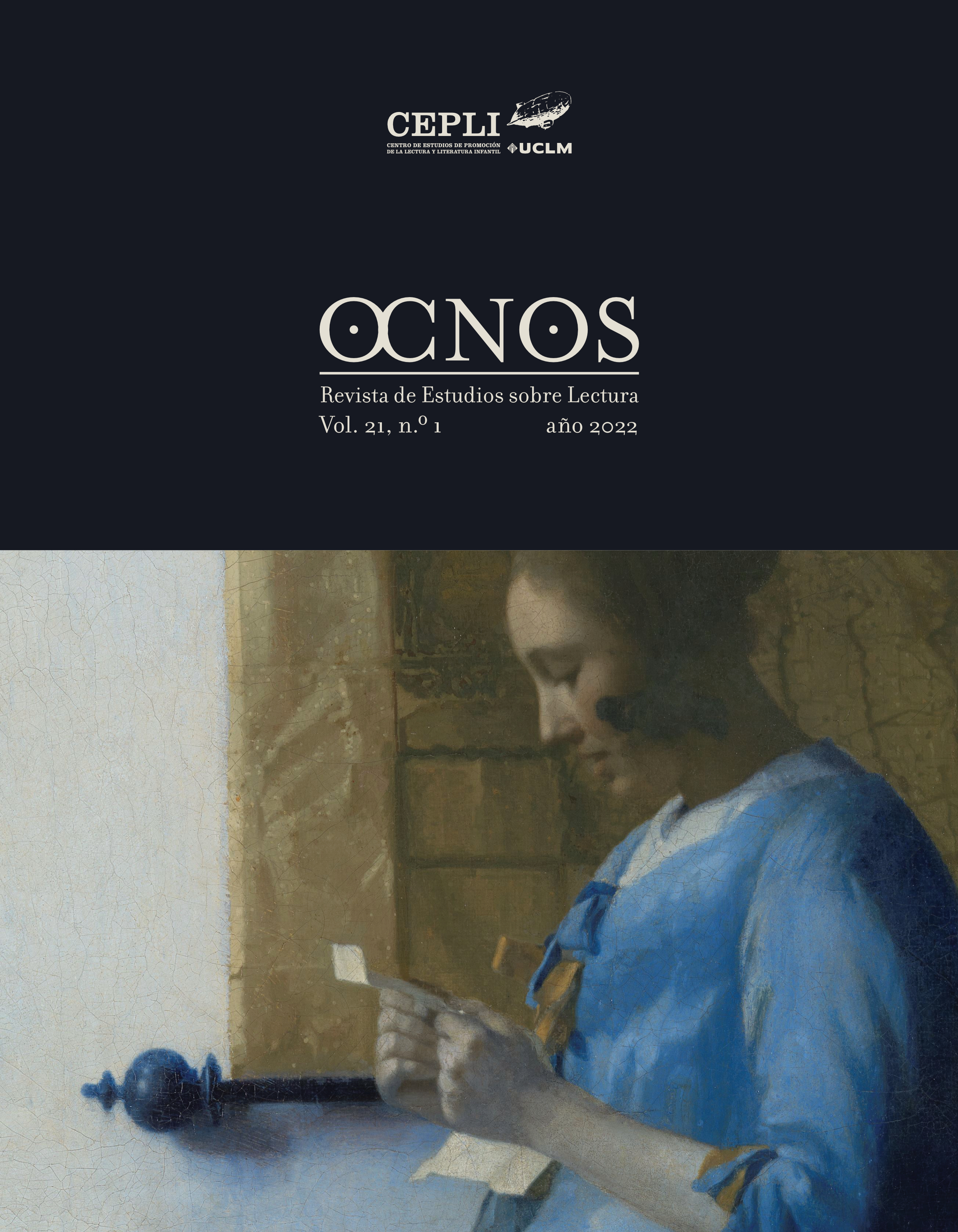An introduction. The picture book as a literary genre
The picture book has become an emerging genre in Children’s and Young Adult Literature (LIJ, as per its Spanish acronym). Nowadays, its consolidation as a literary product is indisputable, although its definition and characterisation are still difficult given the heterogeneous and eclectic nature of the works, and the diversity in the forms of text/image link proposed therein (Silva-Díaz, 2005a). For these reasons, Bader (1976, as cited in Arizpe & Styles, 2004, p. 43) states that “the picture book is text, illustrations, total design; it is a work of manufacture and commercial product; it is a social, cultural, historical document and, above all, it is an experience for children”. For all these reasons, it should be defined as a literary artefact open to freedom, originality, experimentation and innovation, which materialises in a variety of styles and formats that does not allow for generalisations (Prades, 2017).
The use of two codes, textual and visual, in the same work is what defines picture books in first instance. However, Castagnoli (2017) insists that the definition of genre should not be reduced to this idea, as it is possible to identify the co-presence of both languages throughout the history of picture books. The coexistence of text and illustration is not what really identifies picture books, but the way in which this link is established, “in such a way that they depend on each other in picture books that the text is meaningless without the illustrations and vice versa” (Hanán-Díaz, 2020, p. 15). Words and images “act synergistically in combination”, understood as a combination in which both agents “have a greater effect than each would have separately” (Silva-Díaz, 2006, p. 25).
It is also true that picture books “have continued to add new elements that enrich their concept” (Hanán-Díaz, 2020, p. 16) throughout their evolution. In addition to the classic definition of the interdependence between text and image, we must add the importance that paratextual components associated with the materiality of the book are acquiring, and which are incorporated into the reading process as significant elements: “Each of these transformations broadens our concept picture book, re-signifying it and extending its scope” (Hanán-Díaz, 2020, p. 16). Therefore, picture books should be conceived as a total work, as a “medium of expression whose primary unit is the double page, on which images and text are interactively inscribed, and which follows an articulated concatenation from page to page” (Van der Linden, 2015, p. 29).
The emergence and consolidation of picture books was possible thanks to the socio-cultural moment that arose in the second half of the 20th century and which we know as postmodernity, characterised by profound transformations in the way of doing, being and knowing about people, in the way of communicating and in the globality of the intellectual sphere (Duran, 2007). In the field of literature, the effects of postmodernity are enshrined in features such as the rejection of realism, the construction of open narrative structures, the hybridisation of genres, intertextuality and the interpellation of the reader (Silva-Díaz, 2005a). When these parameters are transferred to the field of children’s and young adult literature, picture books become the postmodern genre of LIJ par excellence, “the main area of manifestation of postmodern innovations” (Silva-Díaz, 2005a, p. 28) and “a new narrative genre, which can be included in the cultural artefacts of postmodernity” (Duran, 2007, p. 216).
Picture books - initially born out of the interrelation between text and image - have thus developed into an extremely innovative and complex art form. Far from being reduced to a simple type of book, therefore, picture books can become one of the most complex genres of LIJ, as they can be defined as something more than a book: “It is the embodiment of a form of communication, based on a form of representation, which leads to a new 'way of reading': a way that did not exist before postmodernity and which is extraordinarily suited to it” (Duran, 2010, p. 187).
Subversive rewritings through the ceding of narrative voice
Focus and narrative voice are a fundamental aspect in the study of picture books because, as Gressnich and Meibauer (2010) suggest, “within any picture book, complexity arises especially due to the many changes of perspective from page to page” (p. 212). In first place, it should be borne in mind the divergence that occurs between the two concepts in the framework of picture books: because the games between “from where the story is told” (the focus, the perspective, the point of view from which one speaks) and “who tells” (the narrative voice, the channel through which the information is transmitted, the voice that the narrator adopts to tell the story), are a very frequent resource that often brings great structural complexity.
Actually, the twists and turns and alterations of focus and narrative voice are not a characteristic of picture books, but a resource that can be extended to current children’s literature. According to Colomer (2005), the traditional narrator’s voice helps the reader to manage the story: it expresses hypotheses about what happens, synthesises parts of the story, establishes connections between events, anticipates situations, and even makes explicit the moral lessons to be drawn from the story. Omniscience - the narrator knows everything and distributes the game among the characters, telling what they do and what they think - is the oldest and most habitual form of storytelling. It is linked to the oral transmission of literature; however, in the field of LIJ, this adult and omniscient narrative voice has entered into crisis, and has been replaced by other forms of narrative perspective in which the author dispenses with the comfort of an omniscient narration (Colomer, 2002).
Current children’s and young adult literature shows a clear process of diversification of the voices that narrate, which leads us to “confirm that the all-powerful narrator who took the floor to speak with a direct and firm voice to children, to the approval of adults, is increasingly distant” (Colomer, 1998, p. 27). Picture books are no strangers to these processes and, according to Tabernero (2018), one of the fundamental aspects of the genre is “the identity of the voice that tells, that looks”, so that “apparently simple picture books complicate their construction of meaning from the game that is established between what is narrated and the different points of view elaborated, either through the image or through the word” (p. 48). Within this progressive multiplicity of the type of narrator who tells the story, “The cession of the narrating voice to the characters” (Colomer, 1998, p. 25) is one of the most explored forms. It is therefore possible to find an important corpus of picture books that play with this resource in the adaptation of traditional tales: they offer rewritings of classic texts that deviate from the original versions because stories are narrated not from the perspective of an omniscient observer, but from that of one or several characters who take part in them.
This mode of intertextual invocation has, initially, thematic consequences. The gaze of the character who narrates twists the plot and offers a different story to the one we know. The reading oscillates between a “focused narrator [who] is ‘weak’ insofar as he offers a partial view of what is narrated” (Tabernero, 2018, p. 48) and the traditional version of the story, which leads us to question the facts and invites us to reflect, beyond the story itself, on the plurality of views that the same event arouses and on the importance of the perspective from which we contemplate life. However, this idea is articulated from a formal strategy directly linked to the perspective: ceding the narrative voice to the characters. We are faced with a process that could be called “thematisation of the point of view”, thanks to which a constructive technique becomes the thematic axis of a work: in such a way that the point of view that narrates and the gaze that observes transcend the merely morphological plane and invade the thematic space. This conversion of focus into theme does not only allow us approach the interrelation established between form and content, but also confirms the significant functionality of constructive practices in the hermeneutic and cognitive process associated with reading.
Moreover, these recontextualisations trigger a process that is very representative of postmodern culture: the decanonisation of our literary tradition (Silva-Díaz, 2005a). Therefore, we are not only talking about a transgression on a thematic level, but also on a semiotic level and in a double direction: because the story, narrated in the characters’ words, differs from the canonically accepted original version; and because the characters, relocated in a new context, lead to a disruption of stereotypes. We are thus witnessing a process of disruption of the traditional children’s imaginary, through picture books that offer “new, personal and risky re-readings of well-known themes and characters” (Palacios & Uyá, 2018, p. 22). LIJ texts have an indisputable intertextual nature that allows them to “project and maintain values, forms, structures and referents of literary culture” (Mendoza, 2001, p. 148). Now we are faced with rewritings that do not faithfully reproduce the model, and which therefore call into question the veracity of stories passed down from generation to generation: because intertextual references are used with a subversive intentionality aimed at transgressing conventions consecrated as canonical by tradition (Mendoza, 2012). The deviation from the original version responds to a disruptive will that is linked to a process of cultural recataloguing.
Analysis methodology
The contrastive analysis of four paradigmatic works will allow us to see how picture books propose to rewrite an entire literary heritage by playing with the effects of perspective. The selection was based on a large corpus of 90 works that played with focalisation as a constructive technique; from this starting point, the criteria of literary quality and representativeness were applied. On the one hand, these are books highlighted as benchmarks of the genre by critical studies and specialised publications; on the other hand, the four picture books coincide in rewriting traditional tales from a subversive attitude, shifting the point of view from omniscience to internal focus.
The selected works were published between the 1980s and 1990s. The first of these, John Chatterton détective by Yvan Pommaux, is a collection of three stories that the author published independently: John Chatterton détective (1993), Lilas (1995) and Le grand sommeil (1998). The picture book The jolly postman or other people’s letters (1986) is a classic of children’s literature written by Allan Ahlberg and illustrated by Janet Ahlberg. Our tour will conclude with two picture books by Jon Scieszka (writer) and Lane Smith (illustrator): The true story of the 3 little pigs! by A. Wolf, was published in 1989; and The stinky cheese man and other fairly stupid tales, published in 1992.
The methodology that will guide our exploration is qualitative and is based on the criteria of comparative literature (Guillén, 1985). As a discipline of critical analysis, it aims not only at comparing texts but at analysing the dialogue between them above all. Therefore, beyond the individual study of the works from a comparative point of view, we intend to observe the intertextual plot that underlies them in order to assess the impact of these interrelations on the processes of reading and interpretation.
Analyses of picture books narrated by classic characters
John Chatterton détective
The picture book John Chatterton détective tells three stories where the main character, the famous detective John Chatterton, must solve cases that refer to classic tales. In the first one, inspired by the story of Little red riding hood, a mother comes to him to investigate the disappearance of her daughter, a little girl dressed in red who has been kidnapped by a sinister character in the guise of a wolf. In “Lilia”, which refers to the story of Snow white, the detective is hired by a woman who reports the disappearance of her stepdaughter, who has actually run away to save her life because she distrusts her stepmother, a cruel woman who envies her youth and beauty. “Le grand sommeil” is inspired by Sleeping beauty, and tells the story of how Chatterton is hired by concerned parents to watch over their daughter, who at birth was the victim of a curse that she would be pricked by a spindle on her 15th birthday and fall into a deep sleep.
In the three stories it is possible to identify different processes of rhetorical hybridisation: at a graphic level, the picture book’s resources combined with comic book codes; at the semantic level, the stories refer to the detective novel of the 1950s in their aesthetics and content, and to Grimm’s fairy tales in their plot (Van der Linden, 2015). The result is thus a picture book that combines two sub-genres: the comic, from which it basically takes a graphic code that on occasions is close to cinema; and the detective novel, under whose parameters the plot development and even the aesthetics of the story are designed in a tone that is also very cinematographic (setting, characterisation of the characters, etc.).
This hybridisation, very typical of postmodern aesthetics, allows Pommaux to omit the omniscient narration and articulate the narrative development on the basis of illustrations and the direct intervention of the characters -represented in balloons that capture their words or their reflections-. All the images are in the form of vignettes, albeit of varying sizes that can sometimes take up the space of a page or even a double-page spread, thus acquiring a cinematic style. Balloons are not always framed and can reproduce the words of the protagonists as text inscribed in the illustration, associating the character who is speaking with the characteristic graphic sign of the comic.
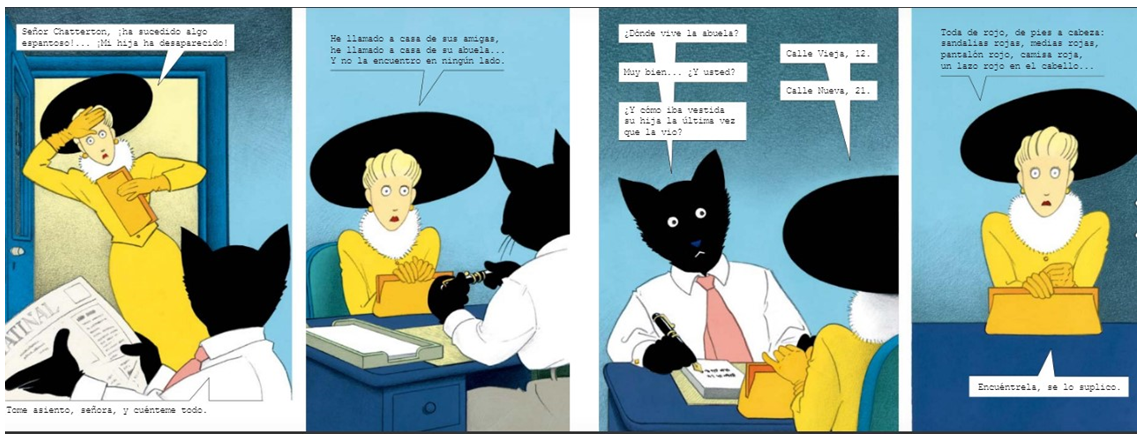 Picture 1
Pictures from John Chatterton détective
Picture 1
Pictures from John Chatterton détective
Note: © 1994 Y. Pommaux © 1994, École des Loisirs, Paris.
The three stories have a similar structure: someone comes to the detective for his services; on the basis of the clues provided, Chatterton begins his search; as he finds evidence, his reflections lead him to new discoveries until the case is solved. But in none of them is there an omniscient narrator: the resolution of the cases faced by the main character constantly swings back and forth between the evidence he uses and what he deduces from it, in a game of alternating perspectives articulated on verbal and visual narration simultaneously. Action is balanced between the point of view of the characters (in whose intervention they contribute their vision of the events), and the point of view of the main character (in a kind of monologue in which he formulates his deductions). In this internal focus, the change of angles in the sequence of events results in a swinging movement that will give the reader a broader perspective on the story: not only the objective unfolding of events, but also the introspective process that leads the detective to solve the cases. This back-and-forth is reinforced by the visual narrative, thanks to the appropriation of a graphic style typical of comics that allows the images to reproduce the alternation between the intervention of the characters and the reflection of the protagonist. This constant shift in approaches that gives the story a thematic dimension that transcends the mere telling of a detective story: Chatterton’s point of view shows the reader, in addition to his speculations, his ability to combine his powers of deduction and his knowledge of literary references.
As an intertextual practice, Pommaux’s stories entail a cultural departure from literary tradition. In this subversive will, according to which the model is not faithfully repeated, but recreated through a process of aesthetic and semantic transformation, the games with narrative perspective and discursive hybridisation play an essential role because they affect the semiotic recataloguing of the folk tale and challenge the reader to reformulate its literary references. These rewritings adopt “the forms of the comic to develop from the outline, topics and images of the crime novel and its transfer to cinema in the mid-twentieth century” (Colomer et al., 2018, p. 154); a new aesthetic that allows old contents to regenerate into new meanings.
The jolly postman or other people’s letters
The picture book The jolly postman or other people’s letters is made up according to parameters parallel to those observed in John Chatterton détective: the classic characters take the floor in the development of the story; the authors use techniques typical of other genres -on this occasion, the epistolary genre-; and the rewriting of the traditional tales that are versioned propose a revision of the culturally inherited stories.
The main theme of the story is the journey of a friendly postman on his bicycle as he goes to different houses to deliver letters. The narrative structure is repetitive: he arrives at each house and delivers the letter; he stays and has some tea while the addressee reads it; and then he says goodbye to make the next delivery. Their movements are described by a narrator who is outside the story and describes the successive scenes in the third person. But the story acquires its full significance when the reader discovers that the story is articulated on an intertextual mechanism: because both the senders and the receivers of the letters are characters from classic tales, whose voices interpellate each other in a dialogic game of cross-references. Thus, Cinderella receives a proposal from a publisher to publish a book about her romantic story; or the wolf is warned by a law firm hired by Little Red Riding Hood to evict her grandmother’s house.
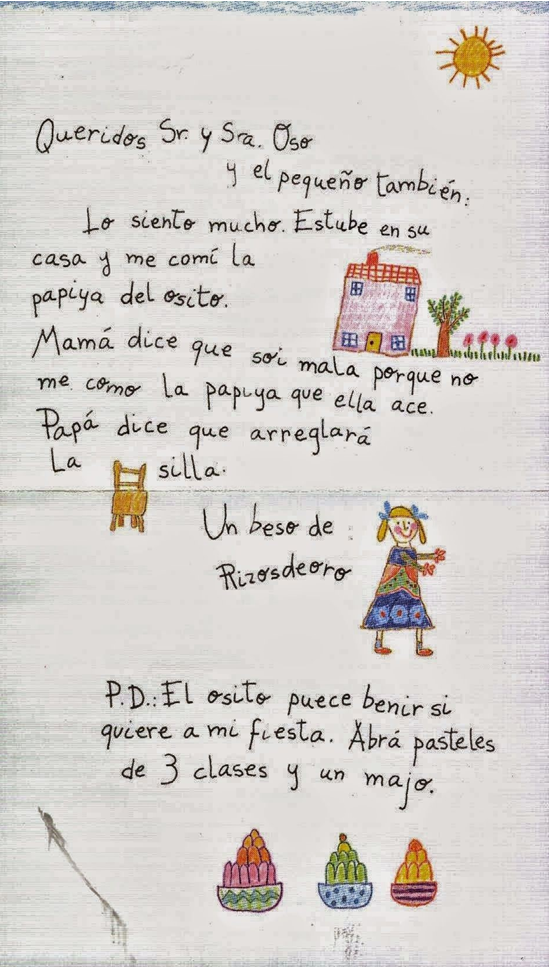 Picture 2
Goldilocks writes to the bear family apologising for her audacity
Picture 2
Goldilocks writes to the bear family apologising for her audacity
Note: © 1986 Allan Ahlberg and Janet Ahlberg © 2002 Hamish Hamilton.
This network of references activates the reader’s literary competence, since both the different types of letters (postcard, legal notice, catalogue) and their contents “are designed according to the character’s story and one has to know the stories very well to be able to get the point of the subject” (Colomer et al., 2018, p. 159). It is a work that, in violation of the canonical character of the classic tales, presents a double challenge: firstly, to identify the literary references; secondly, to interpret the keys of meaning that take us away from the original models to suggest that the stories are unfinished, and that other endings are possible.
The direct interpellation to the reader is not only conveyed through intertextual strategies, but also through a formal construction that incorporates an interactive component. A series of unusual pages are interspersed in the narrative, imitating postal envelopes, where one can see the addressee of the letter and his address, and other elements such as the stamp or the letterhead; when you turn the page, on the back there is an opening that allows you to take out the letter and read it. This book is manipulated, it is “a narrative that uses the possibilities of the format offered by picture books in a metafictional way, blurring the boundary between the story and the medium that contains it” (Silva-Díaz, 2005b, p. 24). Therefore, the narrative linearity is discontinued every time the postman arrives at a house: at that moment, the reader is forced to suspend the story, take the letter that the postman has just delivered out of the envelope, and read it. This entails a change of focus and narrative register: the intertextual reference forces us to place ourselves in another story, that of the folk tale the letter refers to.
This is one of the most representative examples of the adaptation of the epistolary genre to the picture book. The hybrid format plays a key role in the interpretation of the work: thanks to this technique, it is possible not only to transcribe literally the voice of the characters, but also to give the story some credibility. Because the inclusion of the letter as a rhetorical strategy has a great referential capacity, reproducing a common way of communication outside literature. This breaks the tone of fiction and creates a certain illusion of reality: the possibility of holding in one’s hands the letter that the postman has just delivered destroys the line between literary fiction and reality, and generates that effect of indeterminacy so characteristic of postmodern culture according to which reality loses its status of stability (Silva-Díaz, 2005a).
The true story of the 3 little pigs! By A. Wolf
The true story of the 3 little pigs! By A. Wolf should fall within the same pattern. A comparative analysis allows us to place it very close to the previous picture books: firstly, because the narrative voice is again ceded to the main character, who tells the story; secondly, because of the subversive intention of rewriting the literary tradition; thirdly, because in order to achieve this objective, it also resorts to a mixture of compositional strategies typical of other genres.
The play is not just a free adaptation of the classic tale of The three little pigs. The transgressive will goes much further, because the focus of the narrative shifts so abruptly that it is the wolf who explains his version of what happened, completely changing the meaning of the story as we know it. Moving the narrative perspective from an omniscient point of view to a homodiegetic approach that gives voice to the wolf character makes the book a paradigm of the conversion of focus into theme: a process we call “thematisation of the point of view”, which uses a constructive technique - the narrative perspective - with a thematic objective - to propose that other points of view and other interpretations are possible. Thus, in a kind of “revisionist autobiography” (Zaparaín & González, 2010, p. 359), the wolf now becomes the victim: vilified by the press and unjustly accused of a crime, Wolf ends up in prison and decides to explain the events as they happened in order to save his honour. Afflicted by a bad cold, when he was preparing a cake for his grandmother, he ran out of sugar and decided to go and ask his neighbours, the little pigs, for it. As he waited for the door to be opened, he couldn’t help sneezing and, naturally, the thatched and wooden houses were destroyed by the force of his sneezes, and their inhabitants dead: so, he could think of nothing better than to eat them. His third neighbour’s brick house withstood, but the piglet who lived there refused to lend him a cup of sugar: the confrontation between the two was such that the press and the police were attracted to the scene and misinterpreted the conflict. Sensationalist journalists did not find the real story interesting enough, so they transformed it into a big bad wolf who deserved jail time.
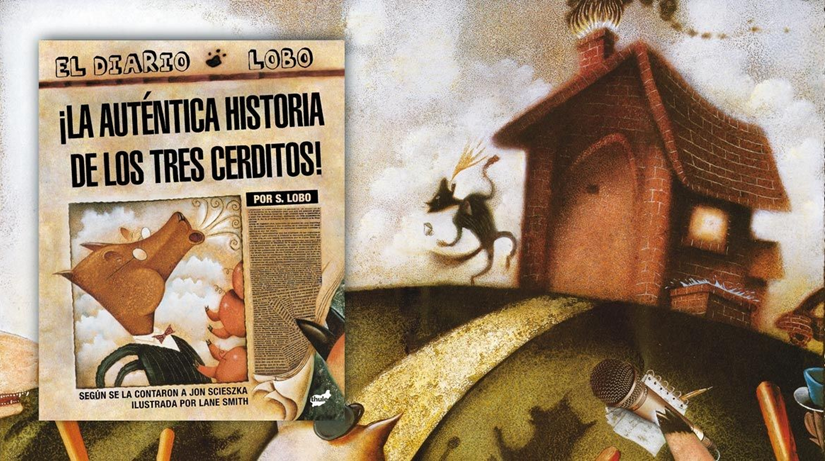 Picture 3
Picture book cover over a double-page illustration of the story
Picture 3
Picture book cover over a double-page illustration of the story
Note: © 1989 Jon Scieszka (texts), © 1989 Lane Smith (illustrations), © 2014 Penguin USA
Beyond an adaptation of the tale, the play proposes a total break with tradition and a reformulation of stereotypes: it aims to show that the well-known and popularly accepted story is false and especially unjust with regard to the figure of the wolf. And to give the story authenticity and verisimilitude to the main character’s version, techniques from other genres - journalism and detective fiction - are used. This double discursive hybridisation thus responds to an obvious intention: the aim is to convince the reader to question the veracity of what he has been told so far, discovering another interpretation of the story. As De Amo and Ruiz-Domínguez (2010) write, “Scieszka manages to imitate and mix aspects of the journalistic genre with those more characteristic of the detective novel with a clear objective: giving more credibility to the story being told” (p. 65), with the purpose of “demonstrating the falsity of the story that has traditionally been told about the tale of the three little pigs and the stigmatisation of the wolf as a perverse character” (p. 65). Irrespective of what reading it may lead to on other thematic-philosophical levels - reflection on media pressure or on justice, empathy with the protagonist - picture books entail a cultural departure that responds to a desire to subvert literary tradition: to achieve this, it cedes the voice to the protagonist and introduces techniques from other genres that allow it to dilute the boundaries between fiction and reality, giving a tone of veracity to the story narrated. Finally, the subversive intentionality with respect to cultural heritage is placed at the service of a clear idea: everything is susceptible to reinterpretation, and even a story endorsed by literary tradition can have a different explanation depending on the angle of vision from which it is viewed.
The stinky cheese man and other fairly stupid tales
In our journey, the work The stinky cheese man and other fairly stupid tales is the culmination of the cession of the narrative voice to the characters. Furthermore, it brings together - in an exponential way - compositional techniques typical of postmodern aesthetics in general and of the picture book in particular, such as typographic disruption, discursive fragmentation or the rupture of the narrative frontier, which are placed at the service of a parodic intentionality.
This picture book is - in principle - an anthology of a series of traditional tales. However, the adaptations of these stories are made in an ironic register that borders on the absurd, following a model of intertextuality that Nikolajeva (2006, p. 228) calls the “anagram type” according to which the order of the stories is deliberately inverted. Thus, the stories are altered on a structural and thematic level “to make a parodic work by mocking the plots, the character of the characters and the inversion of values” (Colomer et al., 2018, p. 160).
The common thread is articulated around Jack, a character who also acts as the narrator of the different stories. But its treatment is absolutely metafictional: Jack directly interpellates the reader by addressing him, mocks the components of the marvellous tale and bursts into the world of fiction to interact with the characters of the stories. This parodic characterisation blurs the narrative boundaries to the point of breaking down the fictional hierarchy of the characters, who rebel and question the authority of the narrator. John, turned victim, jumps from one page to another, watches as characters transform popular stories to suit themselves, and is forced to contain the narcissistic impulses of a hen whose obsession is to explain her story, and even fears for his life at the hands of a giant. In view of the foregoing, e figure of the traditional omniscient narrator - whose prestige as a connoisseur of the truth was unquestionable - is distorted and loses all credibility in the eyes of the reader. Many characters are also given this metafictional configuration that alters the logical order of the narrative levels and allows them to change or abandon their stories, claim their role or interact with the narrator outside their own fiction.
To reproduce the voice of the characters, the authors introduce a typographic game of constant variations, where the text maintains the font but changes size and colour: the letter is red when the Little Red Hen speaks; it is large when the endings are conclusive, as in El patito feo de verdad; it is capital and large when the angry giant of Juan el de la habichuela en aprietos1 speaks; it is progressively smaller when the main character feels he is getting smaller in The story of the youth who went forth to learn what fear was. The typographic games help to place the narration in a parodic register and reinforce the characterisation of the characters, whose voice is materialised through a spelling in keeping with their nature and actions.
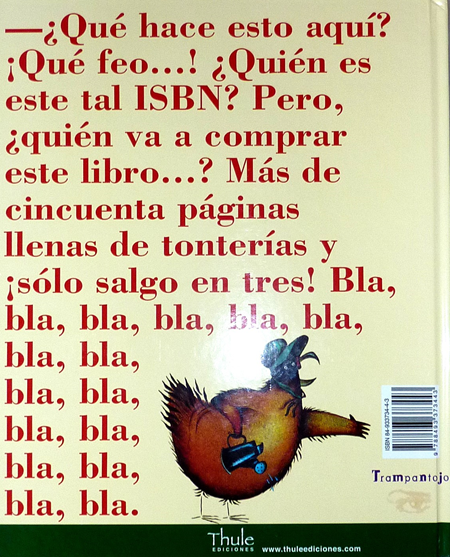 Picture 4
The colour of the letters on the back cover reflects the irritating tone of the words.
Picture 4
The colour of the letters on the back cover reflects the irritating tone of the words.
Note: © 1992 Jon Scieszka (texts)© 1992 Penguin Putnam Inc. (illustrations), © 1992 Viking Books for Young Readers
The treatment of the image is absolutely disruptive, placing itself at the service of a narrative assemblage that is intentionally totally fragmented. Each story has its own illustrations, but between the pages there are characters who disagree with their story and decide to leave it (such as the girl and the wolf in Little red pants), the Little Red Hen who demands to explain her story, Juan the narrator trying to bring order, and even visual elements that are treated in a metafictional way (such as the page containing the dedication, deliberately placed upside down by the narrator).
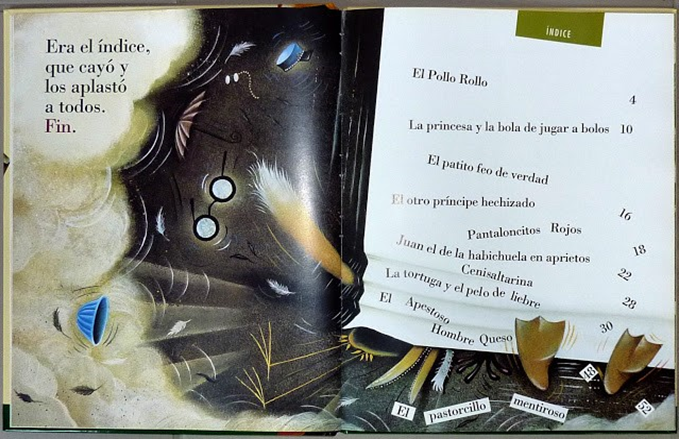 Picture 5
Picture of the Table of contents, which falls, crushing the characters.
Picture 5
Picture of the Table of contents, which falls, crushing the characters.
Note: © 1992 Jon Scieszka (texts), © 1992 Penguin Putnam Inc. (illustrations), © 1992 Viking Books for Young Readers.
The stinky cheese man and other fairly stupid tales proposes “the total break from all typographical and compositional conventions normally respected in a book” (Zaparaín & González, 2010, p. 359). This constructive scheme invites us to leave the purely interpretative dimension and enter the semiotic one, in order to reflect on the literary work from its inscription in the cultural system. Because consolidated conventions such as the integrity of the work, the authority of the omniscient narrator or the unquestionable canonical image of folk tales are reformulated in the light of creative strategies that encourage a reconsideration of the artistic-cultural condition of the book. Consequently, the recipient’s function in literary communication is also reformulated: the dissolution of the narrative boundaries obliges the reader to place himself above the dynamics of the story, in order to decipher the keys of meaning that this dissolution generates. The fact that the characters leave their fictional realm or that the narrator interacts directly with them creates an effect of bewilderment and uncertainty as to how the story will continue. The reader must manage the experience associated with the vulnerability of the work, infer the functionality of that rupture and predict the subsequent development of the actions.
Discussion and conclusions
The transfer of the narrative voice to the characters is a formal technique consolidated in the picture books, which has allowed us to establish morphological associative links between a set of works and to examine comparatively how this use operates in each of them. As a construction strategy, it allows a study on two levels: critical, because it has a significant dimension that is fundamental for the interpretation of the work, so that its incidence is indispensable in the process of creating meanings; and semiotic, because they question traditionally accepted canons and conventions on literary communication, and condition the transmission and durability of an entire cultural heritage.
The substitution of an omniscient voice for a narration put in the mouths of the characters is an architextual mark with a clear argumentative function: the focalisation acquires the thematic capacity to confirm the diversity of perspectives that exist in the perception of the world. But this shift in point of view also has metadiscursive connotations, as the subject interacts with the perspective from which it is narrated, challenging the reader to reflect on the very functioning of the text. The work “does” what it “says”, it invites us to discover the value of the multiple views from the constructive scheme itself. This performative dimension turns a formal technique into a key of meaning that the reader must decipher in order to reach a complete interpretation of the work.
Moreover, the process of rewriting classic tales adds a subversive component that has semiotic implications. From the vision of literature as a great space of creation in which constant connections are established between texts, adaptations have come to be reviewed in the light of intertextuality and dialogism, in order to observe the associations between literary tradition and contemporary culture in the context of social relations (Bellorín, 2015). This has led to moving beyond the traditional notion of adaptation as a downgraded version of the original, to understanding it as the result of a process of “reading”, “interpreting” and “rewriting”. Consequently, “reading” an adaptation means “rereading” the evoked work, in a reciprocity game in which the new work reactivates and reinvents the source text, giving it a new coherence (Heureux, 2009). The cultural departure discovered in the works under study is linked to a process of reactivation of the meaning of the stories referenced: not only is there an insistence on the need to appreciate the diversity of viewpoints, but the veracity of the stories passed down from generation to generation is also called into question. And this also entails a process of revision of canonically accepted concepts such as the unbreakable nature of the unity of the story, the invulnerability of the characters or the authority of the omniscient narrator, which will now have to be reformulated.
All these reflections should be redirected towards the didactic field, given that we are dealing with works that become great instruments for literary education. An education understood not as the knowledge of titles or writers, nor as a process aimed at deciphering the intentionality of an author. Picture books such as the ones studied raise the need to resize literature teaching, to educate in new reading parameters and to advocate for the training of competent readers that progressively turn children into “people increasingly capable of reading and understanding literary texts (and increasingly more complex texts)” (Correro & Real, 2017, p. 43). The structural and interpretative complexity that these books pose have to be managed by the young reader, who will assume new responsibilities: reread a familiar story from another perspective; reflect on literary conventions and assume the absence of stability provided by a single omniscient narrator; decipher how a formal strategy reactivates the thematic content; assess the functionality of compositional techniques such as discursive hybridisation or metafictional resources; and symbolically interpret visual elements, which now act as important keys to meaning. All these requirements propose a reconsideration of the role of the recipient and a new link between the literary work and the reader, ideas that must necessarily be transferred to our classrooms.

